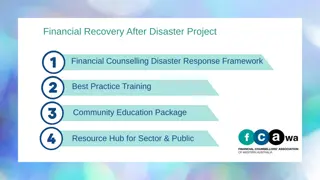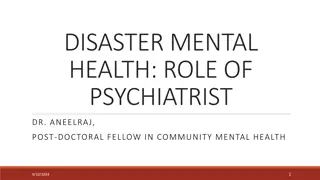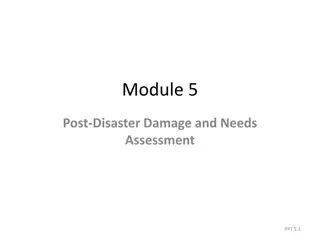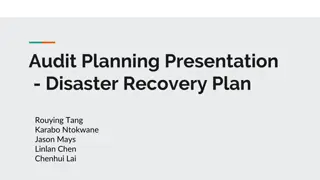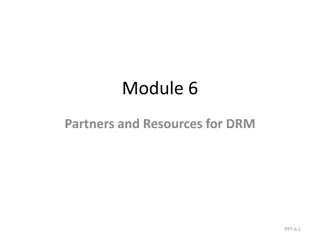Disaster Recovery Operations and Maintenance Overview
Organizations face key challenges in disaster recovery operations, such as widespread disruptions affecting various levels, communities, and suppliers. Prompt reactions and preparedness are essential to navigate through the phases of a disaster recovery plan - preparation, response, recovery, resumption, and restoration. This chapter emphasizes the importance of meticulous preparation, quick decision-making, and the ability to adapt to unforeseen obstacles in the event of a disaster.
Download Presentation

Please find below an Image/Link to download the presentation.
The content on the website is provided AS IS for your information and personal use only. It may not be sold, licensed, or shared on other websites without obtaining consent from the author.If you encounter any issues during the download, it is possible that the publisher has removed the file from their server.
You are allowed to download the files provided on this website for personal or commercial use, subject to the condition that they are used lawfully. All files are the property of their respective owners.
The content on the website is provided AS IS for your information and personal use only. It may not be sold, licensed, or shared on other websites without obtaining consent from the author.
E N D
Presentation Transcript
Principles of Incident Response and Disaster Recovery, 2nd Edition Chapter 10 Disaster Recovery: Operation and Maintenance
Objectives Describe the key challenges an organization faces when engaged in DR operations Discuss what actions organizations should take to prepare for the activation of the DR plan List the critical elements that comprise the response phase of the DR plan Explain what occurs in the recovery phase of the DR plan Describe how an organization uses the resumption phase of the DR plan Principles of Incident Response and Disaster Recovery, 2nd Edition 2
Objectives (contd.) Discuss how an organization resumes normal operations using the restoration phase of the DR plan Principles of Incident Response and Disaster Recovery, 2nd Edition 3
Introduction When disaster occurs organizations need Meticulous preparation and ongoing diligence Quick and decisive reaction to restore operations To prepare to promptly reestablish operations at a new permanent location Each area of the world has its own challenges and risks of disaster Natural or man-made DR plans and procedures are similar to those undertaken for IR and BC actions Principles of Incident Response and Disaster Recovery, 2nd Edition 4
Facing Key Challenges Widespread disasters frequently affect: Departments and various organization levels Communities encompassing the organization Vendors and suppliers Outside help may be unavailable for days or weeks Emergency services, public services, grocers and other suppliers, utility services, private services, telecommunications services, and air and surface transportation Worst-case scenario Seemingly routine event quickly spins out of control Principles of Incident Response and Disaster Recovery, 2nd Edition 5
Facing Key Challenges (contd.) Most disaster-related losses cause: Inability to react properly to the disaster A need to improvise, adapt, and overcome obstacles Most disasters last hours or a few days DR plan phases Preparation Response Recovery Resumption Restoration Principles of Incident Response and Disaster Recovery, 2nd Edition 6
Preparation: Training the DR Team and the Users No prevention phase in DR planning Reason: majority of disasters cannot be prevented Can minimize disaster probability by planning Preparation Being ready for possible contingencies that can escalate to become disasters Develop BIA and DR plans Organize and staff various DR teams Train various stakeholders and practice the plan Principles of Incident Response and Disaster Recovery, 2nd Edition 7
Plan Distribution Must distribute plan to those who need it most Ensure that all personnel: Have access to the plan Have fully read the plan Understand the plan IR, DR, or BC plan storage Physical copy easy to misplace Online storage locations Electronic disruptions could prevent access Principles of Incident Response and Disaster Recovery, 2nd Edition 8
Plan Distribution (contd.) Store password-protected plans where employees can access them At the office Away from the office Online (anytime, anywhere) Password-protecting all electronic files Store physical copies in secure locations Principles of Incident Response and Disaster Recovery, 2nd Edition 9
Plan Triggers and Notification Preparation phase: continuous Other phases: activated by triggers Management notification Employee notification Emergency management notification Local emergency services Media outlets Principles of Incident Response and Disaster Recovery, 2nd Edition 10
Disaster Recovery Planning as Preparation Cornerstone of preparation Developing an effective DR plan DR plan primary goals Eliminate or reduce Potential for injuries, loss of human life, damage to facilities, loss of assets and records Immediately invoke DR plan emergency provisions Stabilize disaster effects Allow appropriate assessment; begin recovery efforts Implement procedures contained in the DR plan Principles of Incident Response and Disaster Recovery, 2nd Edition 11
Disaster Recovery Planning as Preparation (cont d.) CP team engages in scenario development and impact analysis Categorizes threat level each potential disaster poses Generating DR scenario Start with most important asset: people Must test DR plan regularly Ensure DR team can lead recovery effort quickly and efficiently Principles of Incident Response and Disaster Recovery, 2nd Edition 12
Disaster Recovery Planning as Preparation (cont d.) Key features of the DR plan Clear delegation of roles and responsibilities Execution of the alert roster and notification of key personnel Use of employee check-in systems Clear establishment and communication of business resumption priorities Complete and timely documentation of the disaster Preparations for alternative implementations DR team members should know their disaster duties Key personnel may include external groups Principles of Incident Response and Disaster Recovery, 2nd Edition 13
Disaster Recovery Planning as Preparation (cont d.) Key features of the DR plan (cont d.) During a disaster response Verify status of employees, contractors, consultants using manual or automatic procedures First priority: preservation of human life Carefully record disaster from the onset Mitigation of impact Action steps to minimize damage associated with the disaster on operations Principles of Incident Response and Disaster Recovery, 2nd Edition 14
Disaster Recovery Planning as Preparation (cont d.) Additional preparations Two types of emergency information employees need Personal emergency information Snapshot of the DR plan Emergency information often encapsulated into a wallet-sized, laminated card Crisis management Focused steps dealing primarily with the safety and state of the people involved in the disaster DR team works closely with crisis management team Principles of Incident Response and Disaster Recovery, 2nd Edition 15
DR Training and Awareness Training involves different approaches Training should focus on roles individual expected to execute during an actual disaster Disaster preparation limited to awareness training Part of annual or semiannual security education, training, and awareness (SETA) program Make employees aware of general procedures for responding to disasters Principles of Incident Response and Disaster Recovery, 2nd Edition 16
General Training for All Teams Best crisis preparation Ensure employees trained and comfortable in completing normal tasks Training and rehearsals purpose Identify individuals with rusty technical skills Provide opportunity to brush up on responsibilities Vertical and horizontal job rotation Allows preparation for normal personnel shortages or outages Practice degraded mode operations Principles of Incident Response and Disaster Recovery, 2nd Edition 17
Disaster Management Team Training Command and control group Responsible for all planning and coordination activities Training, rehearsal, and testing Predominantly communicative in nature Must quickly and effectively communicate resources needed for subordinate teams to function Must communicate directives from higher teams and peer teams Principles of Incident Response and Disaster Recovery, 2nd Edition 18
Communications Team Training Information-dissemination group Responsible for interacting and communicating with the external environment Training, rehearsal, and testing Prepares information notices, news releases, and internal memorandums and directives Sends communications to all groups and teams Informs people of their tasks and responsibilities Should be involved in routine rehearsal and testing Principles of Incident Response and Disaster Recovery, 2nd Edition 19
Computer Recovery (Hardware) Team Training Hardware recovery and reconstitution team Ideally practices and trains during normal operation Training requirements Advanced training to rebuild systems by scavenging parts Knowledge in how to deal with systems damaged by water, heat, and dust Team should work closely with other technology teams Principles of Incident Response and Disaster Recovery, 2nd Edition 20
Principles of Incident Response and Disaster Recovery, 2nd Edition 21
Systems Recovery Team Training Responsible for recovering and reestablishing operating systems (OSs) May rehearse DR duties during normal operations Train to quickly recover system s operating system Responsibilities may be combined with other IT teams Principles of Incident Response and Disaster Recovery, 2nd Edition 22
Network Recovery Team Training Responsible for reestablishing Connectivity between systems and to the Internet Voice communication networks Focus of training Establishing ad hoc networks quickly but securely Wireless technology Team requirements Stash of wireless networking components stored outside the organization Difficult internet connectivity may need vendor interaction Principles of Incident Response and Disaster Recovery, 2nd Edition 23
Storage Recovery Team Training Responsible for information recovery and reestablishment of operations In storage area networks or network attached storage Training needs Rebuilding damaged systems Recovering data from off-site locations Principles of Incident Response and Disaster Recovery, 2nd Edition 24
Principles of Incident Response and Disaster Recovery, 2nd Edition 25
Applications Recovery Team Training Responsible for recovering and reestablishing critical business applications operations Requirements Skills performed during normal operations Coordination and training in operating under adverse circumstances Team will have user representation Team effectiveness Heavily influenced by ability to create an effective liaison with application business units Principles of Incident Response and Disaster Recovery, 2nd Edition 26
Data Management Team Training Responsible for data restoration and recovery Focus of training Quick and accurate restoration of data from backup Should include data recovery from damaged systems May need vendor help to extract data Principles of Incident Response and Disaster Recovery, 2nd Edition 27
Principles of Incident Response and Disaster Recovery, 2nd Edition 28
Vendor Contact Team Training Responsible for working with suppliers and vendors Need to replace damaged or destroyed equipment or services determined by other teams Training best obtained through normal work in equipment procurement Focus of training Methods of obtaining resources quickly as possible Familiarity with preferred vendors Vendor relationships: crucial during a disaster Principles of Incident Response and Disaster Recovery, 2nd Edition 29
Damage Assessment and Salvage Team Training Provides assessment for: Initial damage to equipment and systems on-site Physically recovering equipment transported to location where other teams evaluate it Requires basic background in hardware repair May need to outsource the function Principles of Incident Response and Disaster Recovery, 2nd Edition 30
Business Interface Team Training Works with remainder of the organization Assists in recovery of nontechnology functions Training Combines technical and nontechnical functions Involves interfacing with various business groups to determine routine needs Help desk representatives well suited for this team Principles of Incident Response and Disaster Recovery, 2nd Edition 31
Logistics Team Training Provides needed supplies, space, materials, food, services, or facilities needed at the primary site Require basic training in local purchasing Primary function Serve as health, welfare, and morale support for the other teams doing their jobs Principles of Incident Response and Disaster Recovery, 2nd Edition 32
DR Plan Testing and Rehearsal Testing DR plan elements Can overlap with plan training and rehearsal Rehearsal Occurs when organization practices steps performed during a disaster Testing involves assessment (internal or external) Before performing in a large-scale exercise Provide classroom-style, structured training Plan rehearsal Start small and escalate to larger-scale exercises Principles of Incident Response and Disaster Recovery, 2nd Edition 33
DR Plan Testing and Rehearsal (cont d.) Rehearsal and testing strategies Desk check Structured walk-through Simulation Parallel testing Full-interruption War gaming Principles of Incident Response and Disaster Recovery, 2nd Edition 34
Rehearsal and Testing of the Alert Roster Alert roster Used in IR and BC planning, and crisis management Alert roster document Contains contact information on individuals notified in the event of an actual incident or disaster Must be tested frequently because it is subject to continual change Two activation methods: sequential and hierarchical Principles of Incident Response and Disaster Recovery, 2nd Edition 35
Rehearsal and Testing of the Alert Roster (cont d.) Alert message Scripted disaster description Consists of just enough information so that each responder knows what portion of the DR plan to implement Does not impede notification process Auxiliary phone alert and reporting system Information system with a telephony interface Used to automate the alert process I m okay automated emergency response line Employees call a predetermined number Principles of Incident Response and Disaster Recovery, 2nd Edition 36
Disaster Response Phase Response phase Associated with implementing initial reaction to a disaster Focus Controlling or stabilizing the situation, if possible Response phase designed to: Protect human life and well-being (physical safety) Attempt to limit and contain the damage to the organization s facilities and equipment Manage communications with employees and other stakeholders Principles of Incident Response and Disaster Recovery, 2nd Edition 37
Recovery Phase Recovery of the most time-critical business functions Get back up and running as quickly as possible Even if operations limited to some degree Less critical operations wait until resumption phase Primary goals of the recovery phase Recover critical business functions Coordinate recovery efforts Acquire resources to replace damaged or destroyed materials and equipment Evaluate the need to implement the BC plan Principles of Incident Response and Disaster Recovery, 2nd Edition 38
Resumption Phase Focuses on non-critical functions BIA: guiding document for creating list of primary and secondary functions Goals of the resumption phase Initiate implementation of secondary functions Finalize implementation of primary functions Identify additional needed resources Continue planning for restoration Complex interaction exist between DR plan and BC plan Principles of Incident Response and Disaster Recovery, 2nd Edition 39
Restoration Phase Formally begins once: All damage assessments accomplished Rebuilding of primary site has commenced Restoration phase primary goals Repair damage or select or build replacement facility Replace primary site damaged or destroyed contents Coordinate relocation from temporary offices to primary site or to new replacement facility Restore normal operations at the primary site Stand down the DR teams and conduct the after- action review Principles of Incident Response and Disaster Recovery, 2nd Edition 40
Repair or Replacement Two possibilities in the restoration phase Reestablish operations at the primary site Establish operations at a new permanent site Reestablish operations at the primary site Organization can rebuild facilities at the primary site Continue partial operations while repairs made Best to temporarily relocate the administrative function Principles of Incident Response and Disaster Recovery, 2nd Edition 41
Repair or Replacement (contd.) Move to a new permanent site Occurs if primary site becomes uninhabitable Bulldoze and rebuild Good if organization owns the land May be months before the organization can relocate Select a new location Necessary when organization cannot relocate for an extended stay at temporary locations Selection of new permanent site: complex decision Staff may not be available to relocate families Principles of Incident Response and Disaster Recovery, 2nd Edition 42
Restoration of the Primary Site Occurs once physical facilities rebuilt Must replace office furniture, desktop computers, photocopying equipment, filing systems, office supplies Determine what insurance will and will not cover Examine service contracts Determine if damage or destruction to leased equipment is covered by the provider Principles of Incident Response and Disaster Recovery, 2nd Edition 43
Relocation from Temporary Offices Movement back to the primary site Signals beginning of the end of disaster operations Must be carefully coordinated: not simple Must relocate people and administrative paperwork Must restore data functions and associated computing equipment Data management practices More crucial before and after moves May require movement coordinator Principles of Incident Response and Disaster Recovery, 2nd Edition 44
Resumption at the Primary Site Recover day-to-day operations to stabilize organization and keep it running efficiently Management of employee benefit packages Employee training and awareness programs Organizational planning retreats and meetings Routine progress meetings and reports Long-term planning activities Research and development activities Business now reconstituted and functioning as it did before the disaster Principles of Incident Response and Disaster Recovery, 2nd Edition 45
Standing Down and the After-Action Review Standing down Deactivation of DR teams Releasing individuals back to their normal duties After-action review (AAR) Last activity before declaring disaster officially over Management obtains input and feedback from teams Information combined with official disaster log Official log: legal and planning record and training tool Last step: creation and archiving of the official report Legal document for insurance, parent organization Once archived, disaster over Principles of Incident Response and Disaster Recovery, 2nd Edition 46
Summary Matter of time until a disaster strikes Meticulous preparation and ongoing diligence needed to properly respond DR plan implementation involves five phases Preparation, response, recovery, resumption, restoration DR and business resumption planning goals Eliminate or reduce potential injuries or loss of human life, facility damage, loss of assets and records Stabilize the effects of the disaster Implement DR and BR procedures Principles of Incident Response and Disaster Recovery, 2nd Edition 47
Summary (contd.) Recovery phase Quick critical business function recovery Resumption Focuses on remaining unrestored functions Restoration phase primary goals Repair damage or select or build replacement facility Replace primary site damaged or destroyed contents Coordinate relocation from temporary offices to primary site or to new replacement facility Restore normal operations at the primary site Stand down the DR teams; conduct the AAR Principles of Incident Response and Disaster Recovery, 2nd Edition 48





